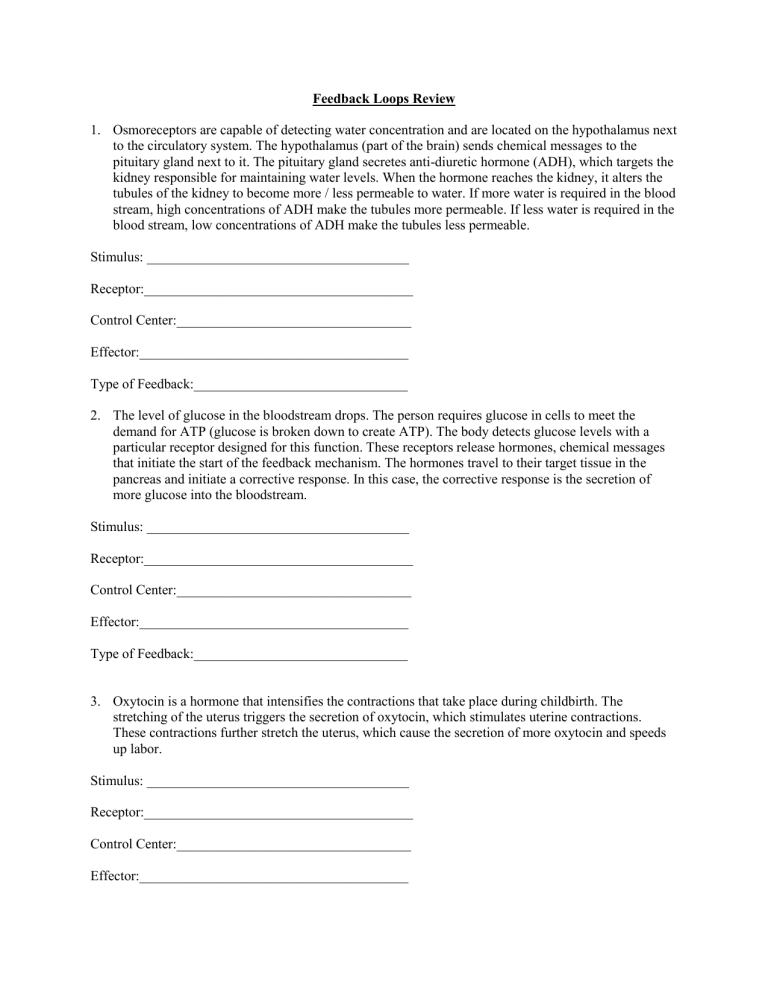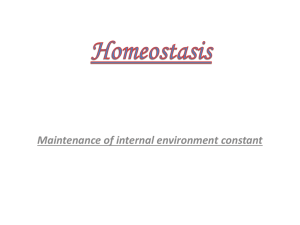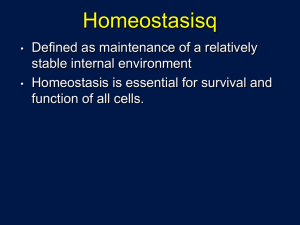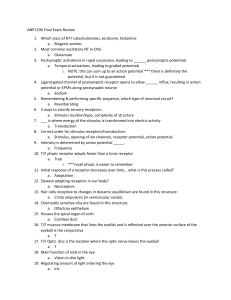
Feedback Loops Review 1. Osmoreceptors are capable of detecting water concentration and are located on the hypothalamus next to the circulatory system. The hypothalamus (part of the brain) sends chemical messages to the pituitary gland next to it. The pituitary gland secretes anti-diuretic hormone (ADH), which targets the kidney responsible for maintaining water levels. When the hormone reaches the kidney, it alters the tubules of the kidney to become more / less permeable to water. If more water is required in the blood stream, high concentrations of ADH make the tubules more permeable. If less water is required in the blood stream, low concentrations of ADH make the tubules less permeable. Stimulus: ______________________________________ Receptor:_______________________________________ Control Center:__________________________________ Effector:_______________________________________ Type of Feedback:_______________________________ 2. The level of glucose in the bloodstream drops. The person requires glucose in cells to meet the demand for ATP (glucose is broken down to create ATP). The body detects glucose levels with a particular receptor designed for this function. These receptors release hormones, chemical messages that initiate the start of the feedback mechanism. The hormones travel to their target tissue in the pancreas and initiate a corrective response. In this case, the corrective response is the secretion of more glucose into the bloodstream. Stimulus: ______________________________________ Receptor:_______________________________________ Control Center:__________________________________ Effector:_______________________________________ Type of Feedback:_______________________________ 3. Oxytocin is a hormone that intensifies the contractions that take place during childbirth. The stretching of the uterus triggers the secretion of oxytocin, which stimulates uterine contractions. These contractions further stretch the uterus, which cause the secretion of more oxytocin and speeds up labor. Stimulus: ______________________________________ Receptor:_______________________________________ Control Center:__________________________________ Effector:_______________________________________ Type of Feedback:_______________________________ 4. An increase in blood pressure is detected by receptors in the blood vessels that sense the resistance of blood flow against the vessel walls. The receptors relay a message to the brain, which in turn sends a message to the effectors, the heart and blood vessels. The heart rate decreases and blood vessels increase in diameter, which cause the blood pressure to fall back within the normal range or set point. Conversely, if blood pressure decreases, the receptors relay a message to the brain, which in turn causes the heart rate to increase, and the blood vessels to decrease in diameter. Some set points become "reset" under certain conditions. For instance, during exercise, the blood pressure normally increases. This increase is not abnormal; it is the body's response to the increased demand of oxygen by muscle tissues. When the muscles require more oxygen, the body responds by increasing the blood flow to muscle tissues, thereby increasing blood pressure. This resetting of the normal homeostatic set point is required to meet the increased demand of oxygen by muscles. Stimulus: ______________________________________ Receptor:_______________________________________ Control Center:__________________________________ Effector:_______________________________________ Type of Feedback:_______________________________ 5. The hypothalamus (a part of your brain) detects fluctuations in temperature. The receptors on it are known as thermoreceptors. Skin also possesses thermoreceptors which can detect the temperature of the external environment. This information is relayed to the hypothalamus which can in turn transmit nerve pulses for corrective mechanisms to occur. If you are HOT, sweating (the water released absorbs heat from your body) and Vasodilation (blood vessels near the skin get bigger – skin may get red- this increases heat diffusion to the outside of your body) occurs. If you are COLD, Vasoconstriction (blood vessels near the skin get smaller- decreases heat loss), and Shivering (muscle movement creates heat) occurs. In extreme cold, blood flow to extremities decreases in order to protect internal organs Stimulus: ______________________________________ Receptor:_______________________________________ Control Center:__________________________________ Effector:_______________________________________ Type of Feedback:_______________________________ 6. Hydrochloric acid and pepsin are enzymes secreted by cells in your stomach to digest proteins. The presence of partially digested protein in the stomach triggers the secretion of more hydrochloric acid and pepsin. Thus, once digestion begins, it becomes a self-accelerating process. Stimulus: ______________________________________ Receptor:_______________________________________ Control Center:__________________________________ Effector:_______________________________________ Type of Feedback:_______________________________



